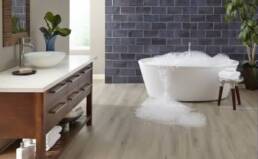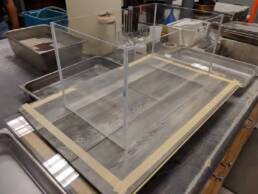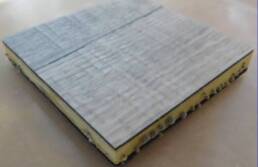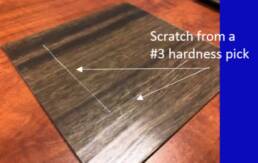
Every day on my way to work, I hear a commercial on the radio offering a variety of floor coverings for sale including ‘waterproof flooring.’ They are talking about vinyl (plastic) flooring which has been around forever in some form or another. However, the plastic flooring industry has recently amped up their marketing machine with some crazy claims. I always grit my teeth because I know that most people hearing that ad won’t realize that the installed floor won’t be waterproof due to the seams. How do I know this? Because I sat in on a very interesting session on this topic given by Eric Astrachan at Coverings this year.

Testing the claims. In his talk, Eric showed a number of slides titled PBM Preliminary Research detailing the claims vs the reality. PBM in this case means “Plastic Based Flooring” and for the sake of the report includes LVT (luxury vinyl tile), LVP (luxury vinyl plank), RCB (rigid core board) and a host of other trendy three-letter acronyms the plastic flooring industry is fond of coining. Ten of these popular products were tested with two standard ways (one US standard and one from Europe) of determining if a system is waterproof. Ten of these popular products failed to stop water from passing through the seams into the subfloor below. If you install the worst performer in your bathroom and your tub overflows while you are at work, almost 50 gallons of water an hour would pass through the plastic flooring into your subfloor. That’s not waterproof or even close to it. Of course, the warranty for these products excludes this type of damage. Some even exclude damage from damp mopping.

Along with water comes – mold. By simulating water trapped under the tiles, it didn’t take very long for mold to start to grow in 90% of the samples tested. The plastic materials in the planks provide a perfect buffet of organics for mold to grow and thrive. Chances are good that if you leave a spill on your plastic floors for more than a few minutes, water will make its way under the tile and find a perfect situation to develop mold, mildew, and VOCs. If you like gross mold pictures, Eric’s report at the link above is full of them.

It doesn’t get better from there. You will often see plastic flooring described as ‘wear resistant’, ‘non-slip’, and even ‘life proof.’ Dogs run across the floors, kids roll toys on them and bathtubs overflow in the ads. Eric’s report goes on to debunk all of these claims. In the fine print you’ll find that the manufacturers tell you not to walk on the products wet. Why? Because they’re slippery when they get wet. Hmm. Likewise these products scratch easily. On the Mohs scale, most of them rate no higher than 3 which is very soft – maybe you’re better than me at keeping your dog’s nails trimmed but yep, Fido can scratch most plastic flooring.
If something sounds too good to be true, read the fine print. There is a lot of fine print with plastic flooring. Water from ‘flooding’ (ie – overflowing bathtubs)? Excluded. Scratching from your pet’s nails? Excluded. Indentations from furniture? Excluded unless you use furniture pads. You DO use furniture pads under all of your table legs, right? Slipping while wet? Excluded. Trust me, I’ve written many product warranties and I would not have wanted my name associated with any of these. The ‘new’ plastic floors are just like the old ones – good for dry areas you don’t walk on. Anything beyond that? Excluded.
